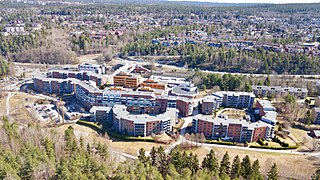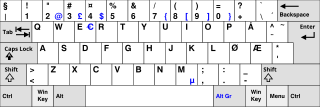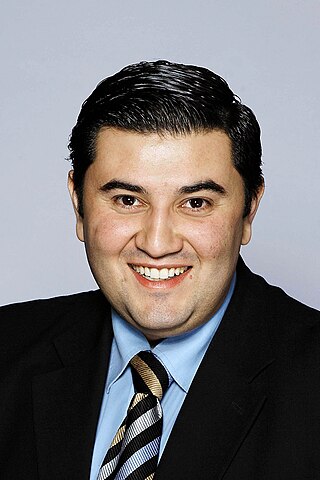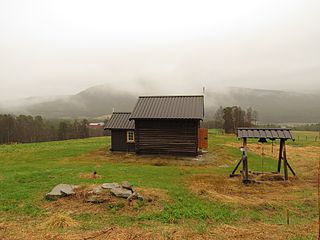
Søndre Nordstrand is a borough of the city of Oslo, Norway. It is the southernmost borough of Oslo, bordering Nordstrand. As of 2020 it has 39,066 inhabitants and the highest rate of immigrant population at 56%. It is the only borough of Oslo that has a majority-minority population.

The Somali diaspora or Qurbajoogta refers to Somalis who were born in Greater Somalia and reside in areas of the world that they were not born in. The civil war in Somalia greatly increased the size of the Somali diaspora, as many Somalis moved from Greater Somalia primarily to Europe, North America, Southern Africa and Australia. There are also small Somali populations in other pockets of Europe and Asia. The UN estimates that in 2015, approximately 2 million people from Somalia were living outside of the country's borders.

Many languages are spoken, written and signed in Norway.
Norwegian Vietnamese or Vietnamese Norwegian refers to citizens or naturalized residents of Norway of partially and full Vietnamese descent.
Pakistani Norwegians are Norwegians of Pakistani descent, 65.23% of Pakistanis in Norway live in the capital Oslo. First-generation Pakistani Norwegians, who migrate from Pakistan, are distinguished from the mainstream in several demographic aspects, while second-generation Pakistani Norwegians, who are born in Norway, are well established in Norway and have gone on to become professionals and politicians.
Family reunification is a recognized reason for immigration in many countries because of the presence of one or more family members in a certain country, therefore, enables the rest of the divided family or only specific members of the family to emigrate to that country as well.
Iraqis in Norway make up approximately 33,924 people. They are mostly refugees from the Iran–Iraq War, the Saddam regime and in particular the Iraq War. Iraqis are the seventh largest immigrant group in Norway after Poles, Lithuanians, Swedes, Syrians, Pakistanis and Somalis.

Mazyar Keshvari is an Iranian-born Norwegian former politician for the Progress Party and a convicted felon who is serving two prison sentences for fraud and violent threats. He was elected as a substitute member of the Norwegian parliament for the city of Oslo in 2013, representing the right-wing and anti-immigration Progress Party, and attended parliamentary sessions from 2013 to 2018 as the substitute of the mandate holder Siv Jensen who has been on leave from parliament during her government service. As a politician he was known for taking a hard stance on immigration, calling for a complete ban on further immigration to Norway, a stop to the practice of accepting asylum seekers in Norway, and the deportation of immigrants convicted of crimes. In 2019 he was convicted of aggravated fraud for defrauding the Norwegian parliament and in 2020 he was sentenced to 11 months imprisonment. He left the Norwegian parliament following his indictment in 2018 and also left the Progress Party in October 2019. In 2019 he was also arrested and charged with making violent threats, and he was convicted and sentenced to an additional four months in prison in 2020.
In 2017, Norway's immigrant population consisted of 883,751 people, making up 16.8% of the country's total population. Of this number, 724,987 are foreign-born, while 158,764 are Norwegian-born with foreign-born parents. The ten most common countries of origin of immigrants residing in Norway are Poland (97,197), Lithuania (37,638), Sweden (36,315), Somalia (28,696), Germany (24,601), Iraq (22,493), Syria (20,823), Philippines (20,537), Pakistan (19,973) and Eritrea (19,957). The immigrant population comprises people from a total of 221 countries and autonomous regions, but 25% of the immigrants are from one of four migrant groups: Polish, Lithuanians, Swedes and Somalis.
African immigration to Norway refers to immigrants to Norway from Africa. An estimated 131,700 people in Norway are either first or second generation immigrants from Africa. Most of these have a background as asylum seekers.

Crime in Norway is countered by Norway's law enforcement agencies.

Poles in Norway are citizens and residents of Norway who are of Polish descent. They are the biggest immigrant group in Norway.
Syrians in Norway are citizens and residents of Norway who are of Syrian descent. Most have arrived as asylum immigrants because of the Syrian civil war.
Somalis in Denmark are citizens and residents of Denmark who are of Somali descent.
Eritreans in Norway are citizens and residents of Norway who are of Eritrean descent. Most have a background as asylum seekers that have fled Isaias Afwerkis regime.
Ethiopians in Norway are citizens and residents of Norway who are of Ethiopian descent.
Moroccans in Norway are citizens and residents of Norway who are of Moroccan descent.
The COVID-19 pandemic in Norway has resulted in 1,489,459 confirmed cases of COVID-19 and 5,732 deaths.

Russians in Norway are people born in Russia or whose parents were both born in Russia and who live in Norway.

On 25 June 2022, two people were killed and twenty-one people were wounded in a mass shooting in Oslo, Norway. Police are treating the incident as an "act of Islamist terrorism". The target may have been the Oslo LGBTQ pride event, which was hosted by the local branch of the Norwegian Organisation for Sexual and Gender Diversity.









